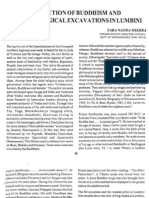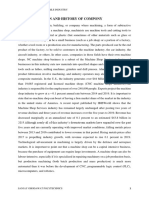Adaptation Conceptual Recearch
Adaptation Conceptual Recearch
Uploaded by
Anthony DukeCopyright:
Available Formats
Adaptation Conceptual Recearch
Adaptation Conceptual Recearch
Uploaded by
Anthony DukeOriginal Description:
Copyright
Available Formats
Share this document
Did you find this document useful?
Is this content inappropriate?
Copyright:
Available Formats
Adaptation Conceptual Recearch
Adaptation Conceptual Recearch
Uploaded by
Anthony DukeCopyright:
Available Formats
Adaptation: Research on Mt. Heng The trip from the foot of Mount Heng to Zhurong Peak is thirty-six li.
When arriving at the "Mid-Mountain Pavilion," you are halfway up to the top of Mount Heng. There is a rhyming couplet inside the pavilion that says, "Follow the path, but you must persevere even at the half-way point. What your heart desires is not far away, but you must accept the challenge if you wish to reach the top." The South Heavenly Gate (Nan Tian Men) serves as a prelude to the summit. Looking up at the Gate, you will see another couplet that says, "This gate leads to heaven, where you get close to the sky and stars. The path leads to the summit, where all other mountains are beneath you." This couplet gives you a mental picture of the majestic view from Mount Heng. There is a story behind the name "Southern Mountain." According to legend, Zhurong was a civil official at the royal court of the Yellow Emperor (Huang Di). Back then, mankind knew how to make fire by using a stick to "drill" a piece of wood but did not know how to preserve the flame and use fire. Zhurong had an affinity for fire and became an expert on it. The Yellow Emperor thus appointed Zhurong as the principal governor of fire. Because Zhurong was also familiar with the affairs of the southern regions, the Yellow Emperor also appointed him as the administrative official in charge of affairs there. Zhurong lived, died, and was buried on Mount Heng. The Five Sacred Mountains are oriented in five different directions. According to the Theory of the Five Elements, each element Metal, Wood, Water, Fire and Earth corresponds to one of the five different directions. The direction South corresponds to Fire. Therefore, the mountain where Zhurong, the fire governor, resided became the "Southern Mountain." According to A Collection of Bizarre Stories (Shu Yi Ji), Southern Mountain was transformed from the right arm of Pan Gu, the legendary Chinese god who created the universe. According to The Book of Astronomy (Xing Jing), Southern Mountain corresponds to the Zhen star in a cluster of twenty-eight stars. There is a tiny star next to this cluster of stars, known as the Chang Sha star. Because the Chang Sha star is believed to rule the life span of all men on earth, and Mount Heng is located in the Chang Sha region according to the ancients, Mount Heng is naturally associated with longevity. Subsequently, "May your life be as lofty as the Southern Mountain" became a popular greeting for a person on his birthday. "Southern Mountain" of course refers to Mount Heng. Throughout history, Southern Mountain has often been referred to as "the Mountain of Incomparable Longevity" or "the Mountain that Governs Longevity." Many man-made structures at Southern Mountain are named for longevity, or "Shou" in Chinese. To name a few examples, there are Wan Shou Palace (Palace of Ten Thousand Years), Shou Nin Palace (Peaceful Longevity Palace), Shou Jian Bridge (Bridge of Longevity Ravine), Ren Shou Pavilion (Humanity and Longevity Pavilion), Bai Shou Pergola (Pergola of A Hundred Years), Yan Shou Pergola (Extended Longevity Pergola) and Shou Fo Hall (Longevity and Buddha Hall). Throughout the ages mankind has always had one dream to achieve longevity. The wish for longevity is deeply embedded in Chinese culture. Therefore, every Chinese person is generally familiar with theories on taking care of personal health. Many types of fitness training programs targeted at reaching longevity and better health have been developed. Many famous traditional Chinese medical doctors invented schools of Qigong or other exercises to achieve longevity, such as "The Exercises that Imitate the Movements of Five Animals," invented by the famous physician Hua Tuo.
The subject of life and death has always been a popular topic in human society. And despite the fact that man has always fantasized about longevity, mankind has never been able to escape death and the cycle of reincarnation or samsara. Countless men throughout history tirelessly tried to resolve the mystery of life and death to escape samsara. The First Emperor of the Qin Dynasty spared no expense in trying to find a way to achieve longevity. Some of his efforts included sending people to famous mountains and riverbanks for magical herbs and sending Taoists to Japan for magical Dan, a special pill forged by Taoists to reach longevity. However, the First Emperor eventually died like everyone else despite his expensive efforts. Only a select few have ever learned that one could only be released from samsara through cultivation. There were many Buddhists and Taoists on Mount Heng. In fact, Mount Heng is revered as an important cultivation site for both Buddhists and Taoists, including those in Japan, other parts of Southeast Asia and the rest of the world. People from all over the world have come to Mount Heng to pay tribute to the temples and palaces. Taoists cleared caves on Mount Heng for cultivation as early as during the West Zhou Dynasty. Temples were first built on Mount Heng during the Liang and Chen of the Six Dynasties (222 589 A.D.). Monk Hui Si built Fu Yan Temple (Temple of Blessings Through Persevering in Cultivation) and Can Jin Hall (The Hall of Buddhist Scriptures Library), which still remains on Mount Heng today. Hui Si's disciple, monk Zhi Yu, later went to Tian Tai Mountain and established the Tian Tai branch of Buddhism. During the Tang Dynasty when Buddhism prevailed and flourished, there was a marked increase in the number of cultivation spots and temples on Mount Heng. The most famous ones during this period were "Ten Giant Forests of Cultivation" and "Eight Hundred Cottage Temples." There is a Chinese saying, "Monks are the most common residents on all revered mountains." Why were there so many temples and monks on Mount Heng? Why did they choose to cultivate on Mount Heng? One of the reasons might have been that Mount Heng symbolized longevity, and one of their goals in cultivation might have been to reach longevity. But that might not have been the true reason why monks throughout the ages favored Mount Heng. One can reach consummation and release oneself from the cycle of samsara through cultivation [Editor's note: and this location may have been beneficial for their cultivation.] In the cultivation arena, the ability of being able to "fly up into the sky in broad daylight" is regarded as a sign that a person has freed himself from samsara. There was a story, for example, that described how the Lady Wei flew up into the sky in broad daylight on Mount Heng. Ms. Wei Hua-Cun, also known as Wei Xian-An, was a famous Taoist cultivator during the Eastern and Western Jing Dynasties. Her cultivation story was recorded in both Mao Shan Zhi (Stories of Mao Mountain) and "The Lady Wei of Mount Heng." She was originally from Ren City in Shandong Province and was the daughter of the Duke of Wen Kang, Mr. Wei Shu. Ms. Wei married Mr. Liu Wen of Xiu Wu County, and had two sons, Liu Pu and Liu Xia. After her husband's death, she went to Mount Heng and lived in seclusion so as to cultivate according to a secret branch of Taoism. Legend has it that the Lady Wei used to cultivate at the Huang Ting Taoist Temple and the Rock of the Flying God outside the temple at Mount Heng. Visitors can still see both these places today. Because Lady Wei cultivated Taoism on Southern Mountain, she was referred to as "Nan Zhen" ("Truthfulness of the South") by the Taoist cultivation community. After sixteen years of cultivation on Mount Heng, Lady Wei's skin looked like that of an infant despite her real age of 84. That was the year she rode on a wheel to soar into the sky.
It was believed that not only people but also trees could reach longevity on Mount Heng. There is a ginkgo tree at Fu Yan Temple that was planted by Monk Hu Si during the Six Dynasties (222 589 A.D.). It is now over 1,400 years old. It takes three adults with arms outstretched to encircle the tree. A white magnolia tree behind the Can Jin Hall is over 500 years old. The Southern Mountain has become a synonym for longevity. As the poem about Mount Heng in the Historical Records of Central Hunan Province goes, "It gives everyone what he deserves according to his virtue." This line reveals a principle of the universe. The universe treats everyone fairly, but one has to be able to be enlightened to its principles and laws.
All information from online source:
http://www.pureinsight.org/node/1595
You might also like
- FedEx (Management Information Systems)Document12 pagesFedEx (Management Information Systems)Nikita Uppal85% (13)
- Law and Education Seminar Paper (140101157)Document22 pagesLaw and Education Seminar Paper (140101157)vaibhav vermaNo ratings yet
- Chen TuanDocument3 pagesChen TuanCarlos Estrada MarzoNo ratings yet
- Liuhebafa Five Character Secrets: Chinese Classics, Translations, CommentaryFrom EverandLiuhebafa Five Character Secrets: Chinese Classics, Translations, CommentaryRating: 5 out of 5 stars5/5 (2)
- Building Your Organization On AutopilotDocument42 pagesBuilding Your Organization On AutopilotAvneetNo ratings yet
- Your Payment Platform Powered by Billplz V2021 130421Document22 pagesYour Payment Platform Powered by Billplz V2021 130421Izzat HanifNo ratings yet
- Quanzhen SchoolDocument8 pagesQuanzhen SchoolJiwen SalimNo ratings yet
- On The Myths of The Yellow Emperor's Eating Jade and Queen Mother of The West's Presenting The White Jade RingDocument18 pagesOn The Myths of The Yellow Emperor's Eating Jade and Queen Mother of The West's Presenting The White Jade RingNadge Frank AugustinNo ratings yet
- The Sutra of Hui-neng, Grand Master of Zen: With Hui-neng's Commentary on the Diamond SutraFrom EverandThe Sutra of Hui-neng, Grand Master of Zen: With Hui-neng's Commentary on the Diamond SutraRating: 4 out of 5 stars4/5 (9)
- Appendix 1Document5 pagesAppendix 1成咪糊No ratings yet
- Hanging Temple in ChinaDocument9 pagesHanging Temple in ChinaTamarapu Sampath KumaranNo ratings yet
- TaoismDocument41 pagesTaoismIsabelle Luna100% (3)
- Shangqing SchoolDocument3 pagesShangqing SchoolJiwen Salim100% (1)
- Shaolin TempleDocument45 pagesShaolin Templenaayram7491100% (1)
- The Life of Lao Tse TungDocument13 pagesThe Life of Lao Tse TungJuan GeronimoNo ratings yet
- 166_ChongYeeTempleDocument9 pages166_ChongYeeTempleOreoNo ratings yet
- Jou Tsung Hwa - Taijiquan HistoryDocument3 pagesJou Tsung Hwa - Taijiquan HistorynqngestionNo ratings yet
- 永嘉玄覺傳記之研究 ─兼談其傳記中之宗派思想Document13 pages永嘉玄覺傳記之研究 ─兼談其傳記中之宗派思想9tonightNo ratings yet
- BON Chapter 1Document10 pagesBON Chapter 1martinNo ratings yet
- Arniko in Wutai ShanDocument9 pagesArniko in Wutai ShanMin Bahadur ShakyaNo ratings yet
- Will You Walk With Me To BorobodurDocument98 pagesWill You Walk With Me To BorobodurUday DokrasNo ratings yet
- Men and Women in He Longxiang's Nüdan Hebian: Elena ValussiDocument37 pagesMen and Women in He Longxiang's Nüdan Hebian: Elena ValussiGabriela-foco OrdoñezNo ratings yet
- 5 TangoDocument19 pages5 TangopempatsheringNo ratings yet
- Sacred Scripture 123Document8 pagesSacred Scripture 123COREi5No ratings yet
- Vishnu Patron Saint of ANGKORDocument32 pagesVishnu Patron Saint of ANGKORudayNo ratings yet
- TaoismDocument12 pagesTaoismRaiysha AuroraNo ratings yet
- 03 Jiri MountainDocument6 pages03 Jiri MountainNicholas SheenNo ratings yet
- Wutai Shan Pilgrimage To Five-Peak MountainDocument136 pagesWutai Shan Pilgrimage To Five-Peak MountainSteve Cline0% (1)
- Records of the Transmission of the Lamp: Volume 7 (Books 27-28) Biographies and Extended DiscoursesFrom EverandRecords of the Transmission of the Lamp: Volume 7 (Books 27-28) Biographies and Extended DiscoursesNo ratings yet
- Tilla JogianDocument8 pagesTilla JogianNasir NaqviNo ratings yet
- Longmen LineageDocument25 pagesLongmen LineageSandino GrullonNo ratings yet
- The Longmen Lineage: Historical NotesDocument27 pagesThe Longmen Lineage: Historical Notesalex_paez_28100% (1)
- 40b.5 Transmission Outside The ScripturesDocument68 pages40b.5 Transmission Outside The ScripturesAadadNo ratings yet
- Chinese Methology (中国神话) : Group IiDocument10 pagesChinese Methology (中国神话) : Group Iikyle AccadNo ratings yet
- Hermeneutics, Phenomenology and Hetroclity in the Kedu Plain BOOKDocument138 pagesHermeneutics, Phenomenology and Hetroclity in the Kedu Plain BOOKUday DokrasNo ratings yet
- Mount Meru and SE Asian ArtDocument139 pagesMount Meru and SE Asian ArtNie Sin ManNo ratings yet
- Chinese mythology (中國神話) is a collection of: cultural history folktales religions creation myths Chinese cultureDocument16 pagesChinese mythology (中國神話) is a collection of: cultural history folktales religions creation myths Chinese cultureWan Sek ChoonNo ratings yet
- Origin of Chinese BuddhismDocument4 pagesOrigin of Chinese BuddhismAriana FerreiraNo ratings yet
- Niña Alexandra N - China ReportDocument3 pagesNiña Alexandra N - China ReportDaisy ManaloNo ratings yet
- 3 F 10Document12 pages3 F 10Zenaid OliveiraNo ratings yet
- Contribution of King Ashoka to the Quintessential EGG Shape of the Buddhist StupasDocument14 pagesContribution of King Ashoka to the Quintessential EGG Shape of the Buddhist StupasUday DokrasNo ratings yet
- Monkey Temple (Swayambhunath) - A Virtual Tour of One of the Most Sacred Buddhist Pilgrimage Sites in the WorldFrom EverandMonkey Temple (Swayambhunath) - A Virtual Tour of One of the Most Sacred Buddhist Pilgrimage Sites in the WorldNo ratings yet
- Gaosengzhuan, Juan 1 (Draft Translation)Document32 pagesGaosengzhuan, Juan 1 (Draft Translation)พรสวรรค์ ปัจจุโสNo ratings yet
- Mongol Pilgrimages To Wutaishan in The LDocument55 pagesMongol Pilgrimages To Wutaishan in The Lc_mosNo ratings yet
- Tsangpa Gyare Yeshe DorjeDocument3 pagesTsangpa Gyare Yeshe DorjeOxyakNo ratings yet
- Campany, To Live As Long As Heaven and Earth, Selected Hagiographies of Transcendents From Ge Hong's Shenxian ZhuanDocument15 pagesCampany, To Live As Long As Heaven and Earth, Selected Hagiographies of Transcendents From Ge Hong's Shenxian Zhuanlorettakong0930No ratings yet
- Taoism: Michelle Azutea Lei Llabres Laurisse Anne Magpayo Juniel Tuazon Zaldy Bryan BajadaDocument26 pagesTaoism: Michelle Azutea Lei Llabres Laurisse Anne Magpayo Juniel Tuazon Zaldy Bryan Bajadana2than-1No ratings yet
- Taoism 1Document37 pagesTaoism 1SalaoNo ratings yet
- Who Built PrambananDocument11 pagesWho Built PrambananUday DokrasNo ratings yet
- Report On PashupatinathDocument17 pagesReport On Pashupatinathsnehi2242% (24)
- Hermeneutics and Phenomenology of BorobudurDocument46 pagesHermeneutics and Phenomenology of BorobudurUday DokrasNo ratings yet
- A Brief History of Tango MonasteryDocument19 pagesA Brief History of Tango MonasteryPransankar MajumdarNo ratings yet
- Swampland Flowers: The Letters and Lectures of Zen Master Ta HuiFrom EverandSwampland Flowers: The Letters and Lectures of Zen Master Ta HuiRating: 4 out of 5 stars4/5 (7)
- Mountains and Their Importance For The Idea of The Other World in Japanese Folk ReligionDocument24 pagesMountains and Their Importance For The Idea of The Other World in Japanese Folk Religionvikidtio100% (1)
- TAOISMDocument29 pagesTAOISMRob Vincent TutorNo ratings yet
- Taoist Feng Shui: The Ancient Roots of the Chinese Art of PlacementFrom EverandTaoist Feng Shui: The Ancient Roots of the Chinese Art of PlacementRating: 4 out of 5 stars4/5 (1)
- Evolution of BuddhismDocument9 pagesEvolution of BuddhismdvdmegaNo ratings yet
- Yggdrasil Script v.2Document2 pagesYggdrasil Script v.2Anthony DukeNo ratings yet
- Dissertation BreakdownDocument5 pagesDissertation BreakdownAnthony DukeNo ratings yet
- Pixel Reign Crit PresentationDocument13 pagesPixel Reign Crit PresentationAnthony DukeNo ratings yet
- Character Design: VillainDocument2 pagesCharacter Design: VillainAnthony DukeNo ratings yet
- Story Idea 1Document2 pagesStory Idea 1Anthony DukeNo ratings yet
- The Vainglorious Watering Can ScriptDocument2 pagesThe Vainglorious Watering Can ScriptAnthony DukeNo ratings yet
- The Vainglorious Watering Can OGRDocument3 pagesThe Vainglorious Watering Can OGRAnthony DukeNo ratings yet
- Unit 4 Art ofDocument10 pagesUnit 4 Art ofAnthony DukeNo ratings yet
- OGR Goldfish BowlDocument5 pagesOGR Goldfish BowlAnthony DukeNo ratings yet
- PMGSY Guideline For Sign BoardDocument13 pagesPMGSY Guideline For Sign BoardSumit HackNo ratings yet
- G.R. No. 176697 - Areza v. Express Savings Bank, IncDocument8 pagesG.R. No. 176697 - Areza v. Express Savings Bank, IncMaria Celiña PerezNo ratings yet
- Edu 606 Childhood Education - Post Course (Michael Essiful)Document18 pagesEdu 606 Childhood Education - Post Course (Michael Essiful)michael essifulNo ratings yet
- RH12Document2 pagesRH12akhilaacommunicationsNo ratings yet
- Health Problem Family Nursing Problem Goal of Care Objectives of Care Intervention Plan Nursing Interventions Method of Contact Resources RequiredDocument4 pagesHealth Problem Family Nursing Problem Goal of Care Objectives of Care Intervention Plan Nursing Interventions Method of Contact Resources Requiredjanesky09100% (1)
- United States of America, Cross-Appellant v. Thomas Mickens, Anthony Jacobs, Shelby Kearney, Bettina Jacobs Celifie, Cross-Appellee, 926 F.2d 1323, 2d Cir. (1991)Document13 pagesUnited States of America, Cross-Appellant v. Thomas Mickens, Anthony Jacobs, Shelby Kearney, Bettina Jacobs Celifie, Cross-Appellee, 926 F.2d 1323, 2d Cir. (1991)Scribd Government DocsNo ratings yet
- Avaliação Diagnóstica de Língua Inglesa 9Document4 pagesAvaliação Diagnóstica de Língua Inglesa 9compras pmNo ratings yet
- LooksmaxDocument1 pageLooksmaxmustafakmal67.34No ratings yet
- Uttarabhadrapada Nakshatra - Vishnu SahasranamaDocument4 pagesUttarabhadrapada Nakshatra - Vishnu SahasranamaDeepak PoojariNo ratings yet
- ARTIFICIAL INTELL《人工智能支持的多任务资源分配战术决策辅助》美海军2022最新108页论文IGENCE-ENABLED MULTI-MISSION RESOURCE ALLOCATION TACTICAL DECISION AIDDocument108 pagesARTIFICIAL INTELL《人工智能支持的多任务资源分配战术决策辅助》美海军2022最新108页论文IGENCE-ENABLED MULTI-MISSION RESOURCE ALLOCATION TACTICAL DECISION AIDniuy485No ratings yet
- Chapter 14 NotesDocument2 pagesChapter 14 NotesmylittlespammyNo ratings yet
- Sheker v. Estate of Alice ShekerDocument7 pagesSheker v. Estate of Alice ShekerReginald Matt Aquino SantiagoNo ratings yet
- Where On Earth Can Go Next?: AppleDocument100 pagesWhere On Earth Can Go Next?: Applepetrushevski_designeNo ratings yet
- Corporate Compliance Management KR ChandratreDocument35 pagesCorporate Compliance Management KR ChandratrewritheNo ratings yet
- Install Kali Linux On Virtualbox in 3 Easy Steps - LinuxForDevicesDocument11 pagesInstall Kali Linux On Virtualbox in 3 Easy Steps - LinuxForDevicesjpaul42391No ratings yet
- Quiz 1Document1 pageQuiz 1na2than-10% (4)
- WERNKE, S. 2003. An Archaeo-History of Andean Community and Landscape, The Late Prehispanic and Early Colonial Colca Valley, Peru PDFDocument664 pagesWERNKE, S. 2003. An Archaeo-History of Andean Community and Landscape, The Late Prehispanic and Early Colonial Colca Valley, Peru PDFEmerz Ángel Gomez ObregonNo ratings yet
- Ielts Recent QuestionDocument12 pagesIelts Recent QuestionRipon Kumar SahaNo ratings yet
- Rain Water Harvesting: Project Report OnDocument16 pagesRain Water Harvesting: Project Report OnShiv RandhawaNo ratings yet
- A Study Applying DCF Technique For Valuing Indian IPO's Case Studies of CCDDocument11 pagesA Study Applying DCF Technique For Valuing Indian IPO's Case Studies of CCDarcherselevators100% (1)
- Integrated Essay TemplateDocument6 pagesIntegrated Essay TemplateSahar Meftah100% (1)
- Tracking Number 56521101030837 Tracking Number PK-DEX046822931Document4 pagesTracking Number 56521101030837 Tracking Number PK-DEX046822931hdfajkhNo ratings yet
- Business Plan - Automobile IndustryDocument9 pagesBusiness Plan - Automobile IndustryYash Patel100% (1)
- Constitution of IndiaDocument2 pagesConstitution of IndiaSuzie ZhiangNo ratings yet
- Magazine Jan 2021Document72 pagesMagazine Jan 2021Abhinav VivekNo ratings yet
- Status of Microfinance and Its Delivery Models in IndiaDocument13 pagesStatus of Microfinance and Its Delivery Models in IndiaSiva Sankari100% (1)


































































































